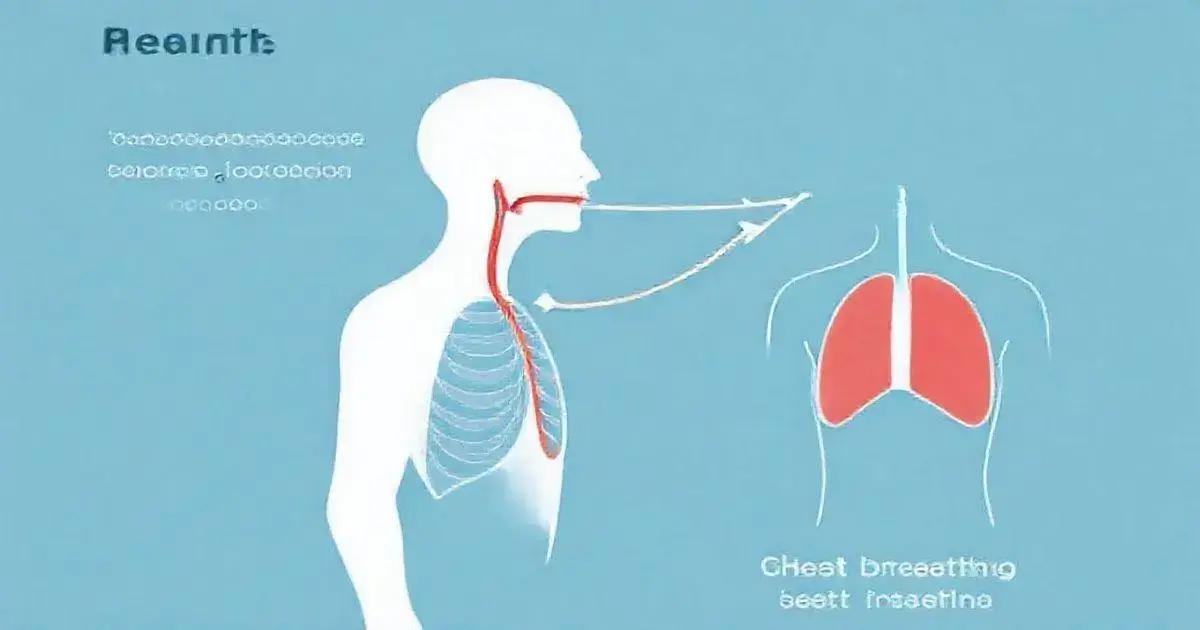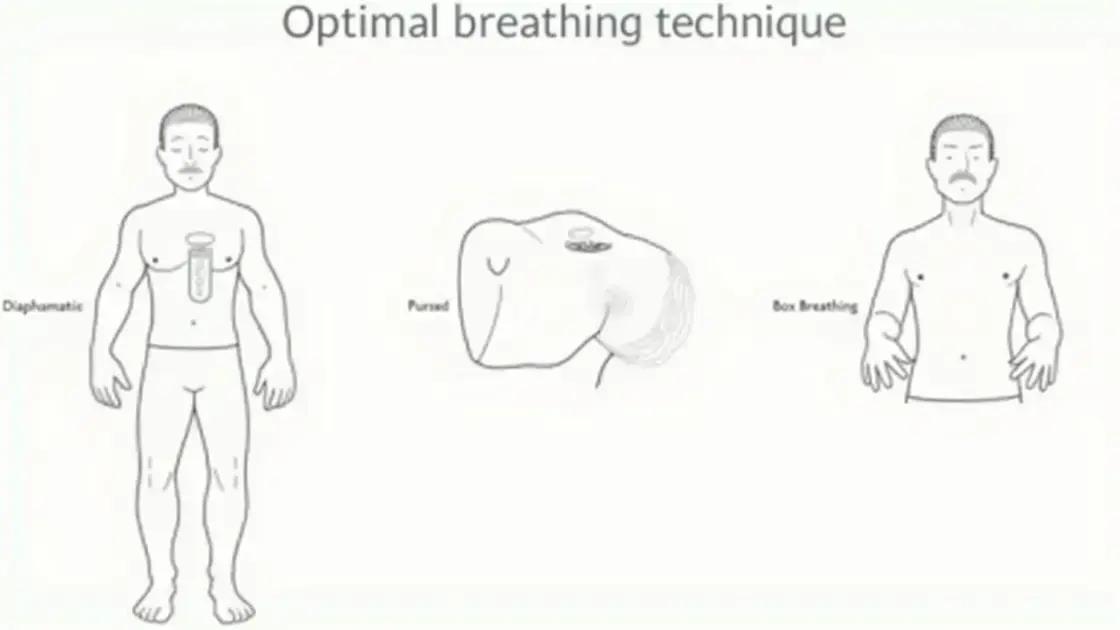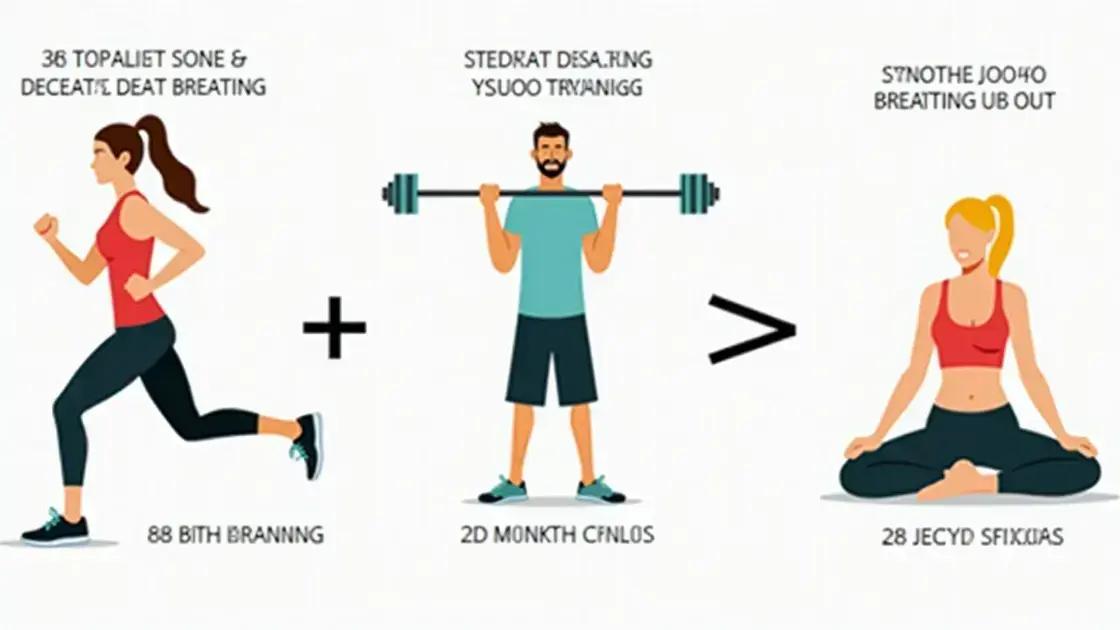Breathing techniques to enhance exercise performance involve methods like diaphragmatic breathing, pursed lip breathing, and rhythmic breathing, which improve oxygen flow, reduce fatigue, and boost overall workout effectiveness.
Breathing techniques to enhance exercise performance are crucial for athletes and fitness enthusiasts alike. Proper breathing not only fuels your body but also optimizes performance and endurance during workouts. In this blog post, we will delve into the science behind effective breathing, introduce you to essential techniques, and discuss how to incorporate these methods into your regular exercise routine. By understanding and improving your breathing, you can significantly enhance your performance and achieve better results.
Understanding the Science of Breathing

Breathing is a vital process that fuels our body with oxygen and removes carbon dioxide. Understanding the science of breathing can unlock new levels of performance during exercise. When we breathe, our lungs take in oxygen and transfer it to our blood, which then delivers it to our muscles. This oxygen is essential for producing the energy needed for physical activity.
The Role of Oxygen
During exercise, our muscles require more oxygen to sustain their activity. As we move, our breathing rate increases to meet this increased demand. This reaction allows our bodies to efficiently convert carbohydrates and fats into energy.
Types of Breathing
There are two primary types of breathing: diaphragmatic breathing and chest breathing. Diaphragmatic breathing, or deep breathing, engages the diaphragm and allows for maximum air intake. This technique helps to reduce stress and enhances oxygen delivery to the lungs. On the other hand, chest breathing is shallow and often leads to decreased oxygen levels, causing fatigue.
The Connection to Exercise
When you understand how breathing affects your exercise performance, you can implement strategies to breathe more effectively. For example, controlled breathing techniques can help increase endurance and improve overall performance. This means less fatigue and better recovery times after workouts.
Conclusion
Incorporating effective breathing techniques into your routine can significantly enhance your exercise performance. With a solid grasp of the science behind breathing, athletes can unlock their true potential and achieve peak performance.
Techniques for Optimal Breathing

Optimal breathing techniques can play a crucial role in enhancing your exercise performance. By mastering these methods, athletes and fitness enthusiasts can improve endurance, reduce fatigue, and boost overall efficiency during workouts.
Diaphragmatic Breathing
Diaphragmatic breathing is one of the most effective methods. To practice it, lie down or sit comfortably. Place one hand on your chest and the other on your abdomen. Inhale deeply through your nose, allowing your abdomen to rise while keeping your chest still. Exhale slowly through your mouth. This technique ensures maximum oxygen intake and reduces tension.
Pursed Lip Breathing
Pursed lip breathing helps control shortness of breath. Inhale through your nose for two counts, then purse your lips as if you’re blowing out a candle. Exhale slowly for four counts. This technique keeps the airways open longer and helps you breathe more efficiently.
Box Breathing
Box breathing is a simple yet powerful method often used by athletes and military personnel. It involves four phases: inhale for four counts, hold the breath for four counts, exhale for four counts, and then hold the breath again for four counts. This technique calms the mind and body, preparing you for peak performance.
Breathing Techniques During Exercise
Incorporate these breathing methods while exercising. For cardio workouts, focus on rhythmic breathing, matching your breath to your movements. During weightlifting, exhale during the lift and inhale during the lowering phase. Adjusting your breathing in accordance with your exercise can enhance strength and decrease fatigue.
The Impact of Breathing on Performance

The impact of breathing on performance is significant for athletes and fitness lovers. Proper breathing techniques can enhance overall workout effectiveness and improve physical capabilities.
Oxygen Delivery
When you breathe well, your body receives more oxygen. This is crucial because oxygen helps produce energy in our muscles. The better your oxygen flow, the more energy you will have, leading to improved endurance and stamina during exercise.
Stress Management
Effective breathing also aids in stress management. By using techniques like deep or diaphragmatic breathing, you can lower cortisol levels, which reduces stress. Lower stress levels mean better concentration and focus during workouts, enhancing your performance.
Fatigue Reduction
Improving your breathing techniques can help reduce fatigue. When you’re breathing correctly, your body uses oxygen more efficiently. This efficient use of oxygen allows your muscles to work longer without tiring, making your workouts more effective and enjoyable.
Breathing During Different Exercises
Breathing impacts various exercise types differently. For example, in cardio workouts, controlled breathing can help maximize performance, while in strength training, exhaling during exertion supports muscle strength. Understanding these different impacts can aid you in tailoring your workouts for maximum efficiency.
Integrating Breathing Techniques into Workouts

Integrating breathing techniques into workouts can significantly enhance your performance. By focusing on your breath throughout your exercises, you can improve endurance, reduce fatigue, and maximize results.
Warm-Up Breathing Exercises
Start your workout with warm-up breathing exercises. Spend a few minutes practicing diaphragmatic breathing to prepare your lungs and body. This prepares your muscles for the increased demand of your workout.
Breathing Techniques in Cardio Workouts
During cardio exercises, such as running or cycling, aim for a steady rhythm in your breathing. Inhale for two steps or revolutions, then exhale for two. This rhythm helps maintain oxygen flow and can improve your stamina.
Incorporating Breathing in Strength Training
In strength training, it is essential to coordinate your breath with your movements. Exhale when you’re lifting (the exertion) and inhale while lowering the weight. This technique supports muscle engagement and can help in preventing injuries.
Mindfulness and Breathing
Incorporating mindfulness into your breathing can also be beneficial. Whether you’re in yoga or a high-intensity interval training (HIIT) session, pay attention to your breath. This focus can improve your connection with your body and enhance your performance during challenging workouts.
Unlocking Your Potential Through Breathing Techniques
Breathing techniques to enhance exercise performance are essential tools that can elevate your workouts. By understanding the science of breathing and applying optimal techniques, you can significantly improve your athletic performance.
Integrating these breathing methods into your workouts can enhance endurance, reduce fatigue, and promote better mental focus. Whether engaging in aerobic training, strength exercises, or mindfulness practices, proper breathing is a game changer.
As you work towards achieving your fitness goals, remember that mastering your breath is just as crucial as the physical training itself. Enjoy the journey of transforming your workouts and unlocking your full potential.
FAQ – Frequently Asked Questions about Breathing Techniques for Exercise Performance
What are breathing techniques?
Breathing techniques are specific methods designed to improve your respiratory efficiency, which can enhance exercise performance and overall well-being.
How do breathing techniques affect performance?
Proper breathing techniques provide more oxygen to your muscles, reduce fatigue, and help with mental focus, all of which improve performance during workouts.
What is diaphragmatic breathing?
Diaphragmatic breathing, or deep breathing, involves using the diaphragm to draw in more air, leading to better oxygen delivery and relaxation.
How can I integrate breathing techniques into my workouts?
You can integrate breathing techniques by practicing them during warm-ups, coordinating breath with movements in weight training, and maintaining rhythm during cardio exercises.
Can breathing techniques help reduce stress during exercise?
Yes, techniques like deep breathing can lower cortisol levels and reduce stress, allowing for better concentration and focus during workouts.
Are there specific breathing techniques for different types of exercises?
Absolutely! Different exercises benefit from specific techniques, such as rhythmic breathing for cardio and coordinated exhale/inhale patterns for strength training.













